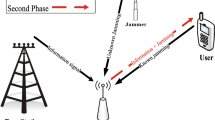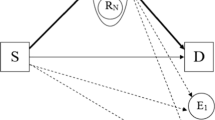Abstract
The characteristics of the wireless medium create difficulty to shield the data transmission from unauthorized recipients. In this paper, power optimization in an amplify-and-forward untrusted relay network is presented, using cooperative jamming transmission to prevent the untrusted relay from intercepting the confidential signals. Considering imperfect channel estimation error at the destination, an optimal power allocation (OPA) is designed to maximize the achievable secrecy rate for the network. Simplified OPA is derived for high signal-to-noise ratio regime with imperfect CSI and the ergodic secrecy rate is also analyzed to evaluate the achievable average secrecy rate for different scenarios as a common performance metric. The numerical results show that when the error of CSI is considered, the proposed OPA generates limited and acceptable degradation on the secrecy rate.






Similar content being viewed by others
References
Zhao, N., Yu, F. R., Li, M., & Yan, Q. (2016). Physical layer security issues in interference-alignment-based wireless networks. IEEE Communications Magazine, 54, 162–168.
Goel, S., & Negi, R. (2008). Guaranteeing secrecy using artificial noise. IEEE Transactions on Wireless Communications, 7, 2180–2189.
Wang, H. M., Zheng, T., & Xia, X. G. (2015). Secure MISO wiretap channels with multiantenna passive eavesdropper: Artificial noise versus artificial fast fading. IEEE Transactions on Wireless Communications, 14, 94–106.
Yao, R., Liu, Y., Lu, L., & Li, G. (2016). Cooperative precoding for cognitive transmission in two-tier networks. IEEE Transactions on Communications, 64, 1423–1436.
Yao, R., Xu, J., Li, G., & Wang, L. (2016). Optimized BD-ZF precoder for multiuser MIMO–VFDM cognitive transmission. ETRI Journal, 38, 291–301.
Dong, L., Han, Z., Petropulu, A. P., & Poor, H. V. (2010). Improving wireless physical layer security via cooperating relays. IEEE Transactions on Signal Processing, 58, 1875–1888.
Li, J., Petropulu, A. P., & Weber, S. (2011). On cooperative relaying schemes for wireless physical layer security. IEEE Transactions on Signal Processing, 59, 4985–4997.
Wang, C., Wang, H. M., & Xia, X. G. (2015). Hybrid opportunistic relaying and jamming with power allocation for secure cooperative networks. IEEE Transactions on Wireless Communications, 14, 589–605.
Nguyen, S. Q., & Kong, H. Y. (2017). Secrecy enhancement in two-hop DF relaying system under hardware impairment. International Journal of Electronics, 104, 442–461.
Zhou, N., Chen, X., Li, C., & Xue, Z. (2014). Secrecy rate of two-hop AF relaying networks with an untrusted relay. Wireless Personal Communications, 75, 119–129.
He, X., & Yener, A. (2009). Cooperation with an untrusted relay: A secrecy perspective. IEEE Transactions on Information Theory, 56, 3807–3827.
Zhang, R., Song, L., Han, Z., & Jiao, B. (2012). Physical layer security for two-way untrusted relaying with friendly jammers. IEEE Transactions on Vehicular Technology, 61, 3693–3704.
Mo, J., Tao, M., Liu, Y., & Wang, R. (2013). Secure beamforming for MIMO two-way communications with an untrusted relay. IEEE Transactions on Signal Processing, 62, 2185–2199.
El-Bardan, R., Brahma, S., & Varshney, P. K. (2016). Strategic power allocation with incomplete information in the presence of a jammer. IEEE Transactions on Communications, 64, 3467–3479.
Taki, M., & Sadeghi, M. (2016). Optimised secure transmission through untrusted AF relays using link adaptation. International Journal of Electronics, 103, 831–840.
Sun, L., Zhang, T., Li, Y., & Niu, H. (2012). Performance study of two-hop amplify-and-forward systems with untrustworthy relay nodes. IEEE Transactions on Vehicular Technology, 61, 3801–3807.
Wang, L., Elkashlan, M., Huang, J., Tran, N. H., & Duong, T. Q. (2014). Secure transmission with optimal power allocation in untrusted relay networks. IEEE Wireless Communications Letters, 3, 289–292.
Khattabi, Y. & Matalgah, M. M. (2015). Conventional and best-relay-selection cooperative protocols under nodes-mobility and imperfect-CSI impacts: BER performance. In Proceedings of IEEE wireless communications and networking conference (WCNC2015) (pp. 105–110).
Salari, S., Amirani, M. Z., Kim, I.-M., Kim, D. I., & Yang, J. (2016). Distributed beamforming in two-way relay networks with interference and imperfect CSI. IEEE Transactions on Wireless Communications, 15, 4455–4469.
Bletsas, A., Shin, H., & Win, M. Z. (2007). Cooperative communications with outage-optimal opportunistic relaying. IEEE Transactions on Wireless Communications, 6, 3450–3460.
Jeffrey, A., & Zwillinger, D. (2007). Table of integrals, series, and products. Cambridge, MA: Academic Press.
Funding
This work was supported in part by the National Natural Science Foundation of China (Nos. 61501376 and 61701407), the Fundamental Research Funds for the Central Universities (Nos. 3102016ZY020 and 3102017JG02002) and the Graduate Starting Seed Fund of Northwestern Polytechnical University (No. ZZ2017128).
Author information
Authors and Affiliations
Corresponding author
Additional information
Publisher's Note
Springer Nature remains neutral with regard to jurisdictional claims in published maps and institutional affiliations.
Rights and permissions
About this article
Cite this article
Mekkawy, T., Yao, R., Xu, F. et al. Optimal Power Allocation in an Amplify-and-Forward Untrusted Relay Network with Imperfect Channel State Information. Wireless Pers Commun 101, 1281–1293 (2018). https://doi.org/10.1007/s11277-018-5762-x
Published:
Issue Date:
DOI: https://doi.org/10.1007/s11277-018-5762-x




